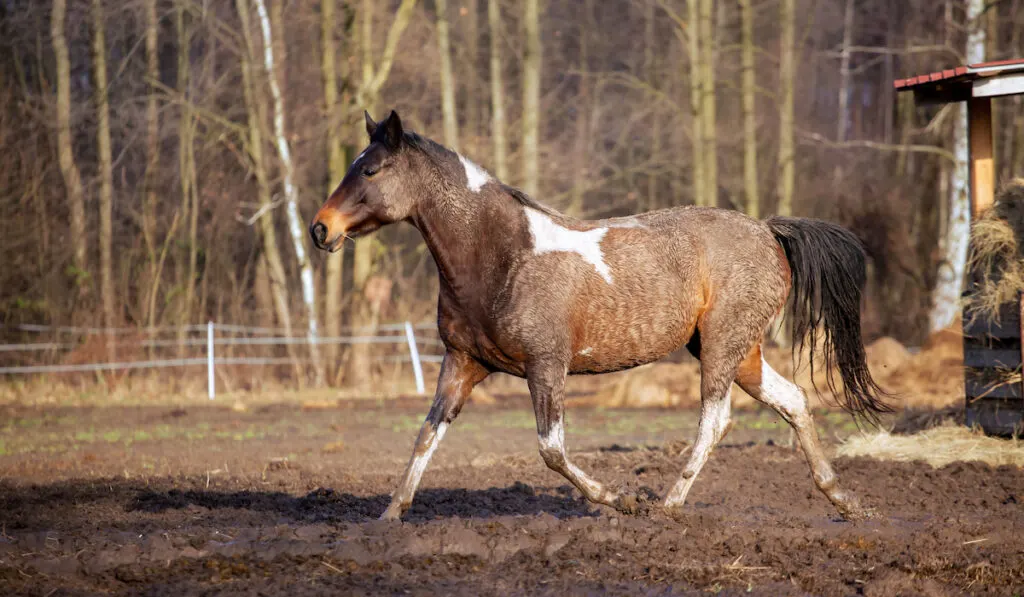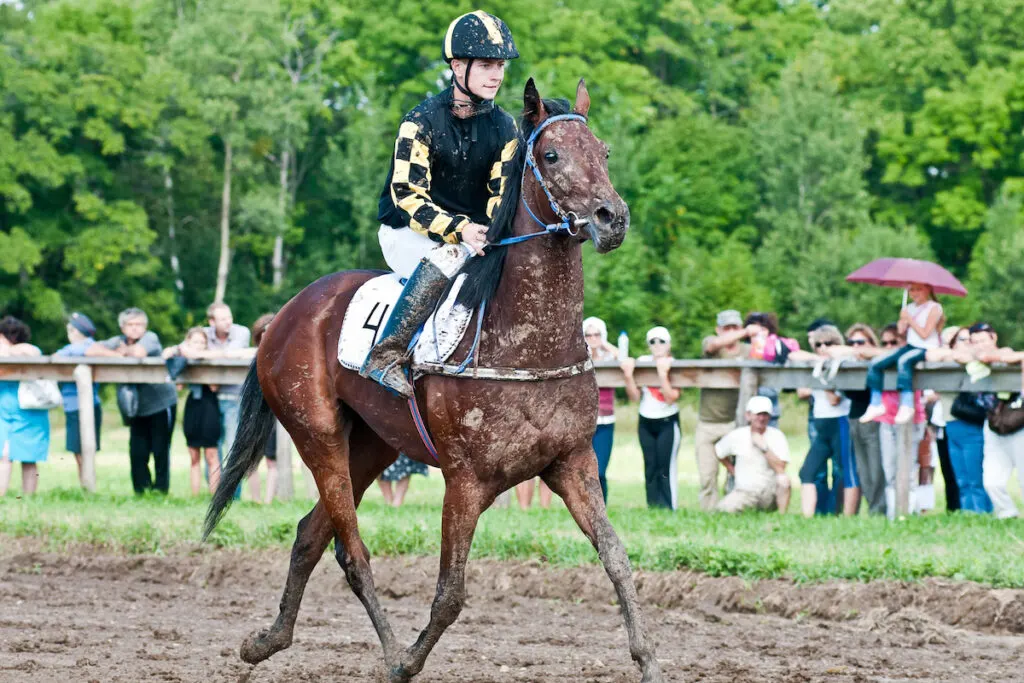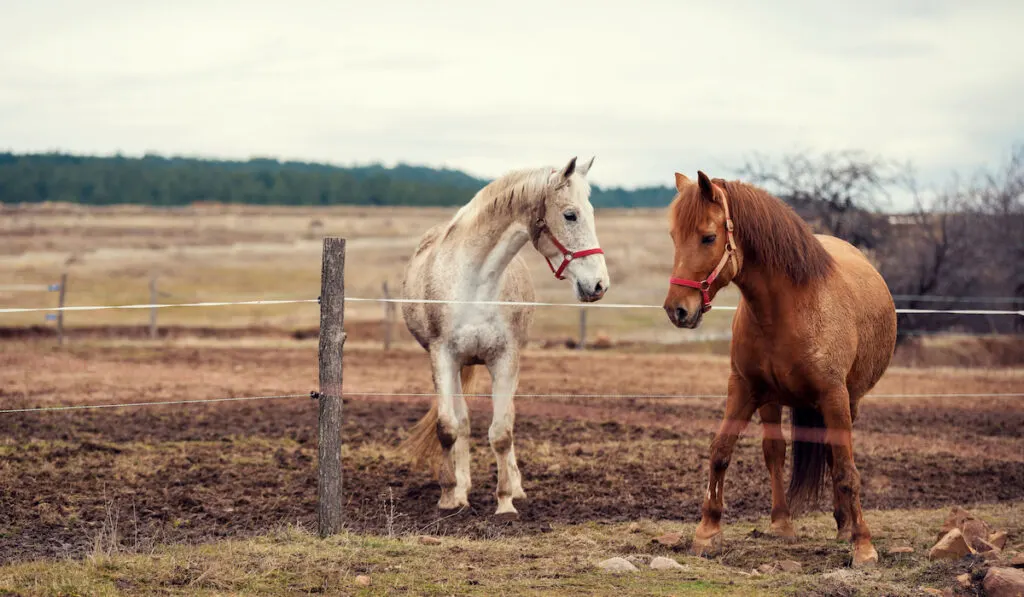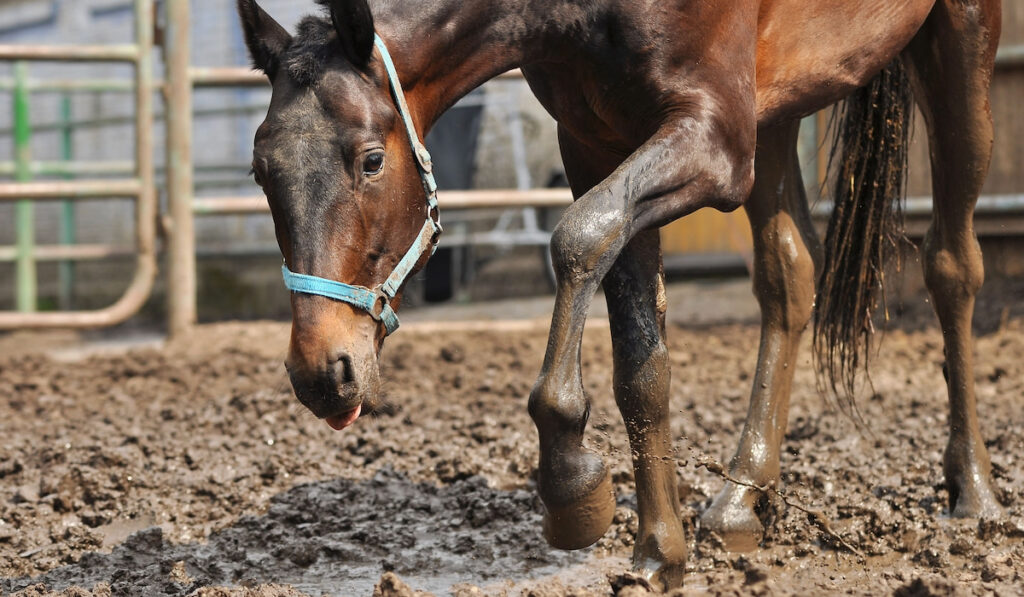For most people, the winter season is about having fun in the snow, spending time with family, and celebrating with some holiday cheer. For horse people, though – winter brings cold, rain, and sloppy, muddy paddocks.
Not only is mud a gross pain in the neck, but it can be unhealthy or even dangerous for your horse.

If you’re looking for a way out of the muck, here are 5 tips to keep your horse from standing in mud that will give you both some relief this winter season.
Table of Contents
Why does my paddock get so muddy, and what does it mean for my horses?
Horses are messy animals – they graze, gallop, and roll, tearing up pasture and turning it into a sloppy mess.
Some horses are messier by nature than others, and they can add a lot of extra waste to an already sloppy paddock. This creates thick mud much faster, especially in a small area like a barn or stall.
This organic slop is filled with dangerous microorganisms that can pose health hazards ranging from mild to severe.
Not only is mud unattractive and unsightly, it’s a pain to clean from a horse’s furry, thick winter coat. It can freeze into lumpy slippery ice and cause slips and falls.
Your horse can also develop some serious health conditions from standing around in mud all day – pastern dermatitis, thrush, or fly-born diseases.
To avoid all of these problems and more, you’ll want to reduce the amount of mud in his pasture – or prevent it altogether if you can.
1. Design your paddocks before the mud becomes a problem.
A Well-designed Paddock is Worth its Weight in Gold
If you’re building your first horse property, you have the unique advantage of planning the space before the mud becomes a problem.
A group of horses hanging around a watering trough at the bottom of a hill is a recipe for disaster, so plan carefully before setting up your pasture elements.
Use the landscape to your advantage: put your important buildings and feeding areas as high as possible, and utilize slopes to keep horses from congregating in low points.
If you want proper drainage, aim for a two-to-five percent grading on hills.
Cost: Paddock implantation costs vary wildly depending on your goals and your landscape, but investing in proper mud-prevention designs will save you thousands in repairs and potentially vet bills down the line.
2. Proper Drainage is Key

Just like houses, buildings that are designed for animals need proper gutters and downspouts. Aim the rainwater away from your buildings and out to a place where it won’t cause a problem.
Once you’ve gotten your gutters in place, be sure to clean them regularly and keep them free of clogging debris.
If your horse housing is well-designed and your gutters are working properly, but you still have poor drainage – you may want to add a French drain (source).
Just make sure to cover it with enough gravel to keep it safe from nosy equines.
Cost: Depending on the number of buildings you have and the square footage of your lot, this price can vary.
Consider lower cost PVC options for your downspouts, and you can dig French drains yourself to save on initial installation costs.
3. Manage Pastures Properly
Once you’ve implemented the perfect paddocks with mud-prevention techniques, you have to maintain them to keep the slop at bay. Vegetation roots will hold the soil together and prevent it from turning into a muddy disaster.

Pasture maintenance can be tricky, but these important steps can keep your larger pastures mud-free and looking great through the winter and beyond.
- Avoid overcrowding. Don’t put too many horses into a pasture that can’t handle it. Generally speaking, aim for one to two acres per horse if they’re living outside full time.
- Rest your pasture. Horses aren’t the only ones who need a break after a lot of work. Give your pasture a rest from its equine occupants for a month or two so the grass has a chance to regrow.
- Collect soil samples. Analyze the pH level of your soil and add fertilizer or lyme where necessary. This will help keep your grass in good shape, which is better for your horses (and for keeping the mud away).
- Create mud-free zones. If you can’t maintain or fix up a large pasture all at once, you can create a small area for your horses to get out of the mud. Block off resting pasture with fencing, or create a “sacrifice area” that’s completely made of gravel or other material. Adding better drainage to smaller areas will help to fix larger problems – but in more manageable chunks.
Cost: If you have the space, these are very low-cost options. Pasture maintenance should be part of your monthly budget, especially if your horses live outside year-round.
Some owners choose to board their horses at another facility during the winter to give their home paddocks a chance to rest, which can cost anywhere from $200 to $1000 per horse per month.
4. Ensure Regular Cleaning
Even large pastures should be kept as clean as possible. Leftover hay and droppings can mix with the soil to create mud faster than just rainwater alone.
Pick out paddocks often, especially in higher-traffic areas or favorite pooping spots.
Even a quick one-over with a rake will spread the surface area of the organic material, which will in turn slow down the muddying process (but manure removal is still your best bet).

Cost: While this is technically a very cheap option, make sure you budget for manure management services. If you’re simply too busy to pick paddocks yourself, create a budget for hiring some help.
Explore Footing Options
While there’s a wide variety of footing options available for horse pastures and paddocks, you’ll have to choose the one that best suits your needs. Here are some popular footing options that can help reduce mud issues (source)(source).
| Footing Type | What is it | Approximate Cost |
| Minus Gravel | Crushed stone in 3/4” and 1” size chunks | $1/ square foot |
| Arena Footing | Combination of sand or rubber products | $.10 – $5 / square foot |
| Hogfuel | Woodchips made from stumps or branches, must be replaced regularly | Around $.30/square foot |
| Sand | Pure sand, although you can get sand/organic material combinations as well | $.20/square foot |
| Turf/Sod | New grass | $4/ square foot |
| Fabric | Adding a layer of fabric can help keep mud from forming, but horses may dig it up. | $.30/square foot |
| Hoof grid | Interlocking plastic grid beneath footing | $.50 – $5/square foot |
| Straw | Provides good bedding for stalls | Varies |
| Mat | Flat rubber flooring is an excellent choice for stalls and indoor areas. | $2 – $10/square foot |
A Note About Stall Mud
Even if your barn has excellent flooring, your horse’s stall can still get muddy. If they’re spending more time indoors because of poor weather outside, you’ll want to make sure their stalls stay as clean and dry as possible.
Make sure water isn’t getting in from a hole in the roof, a leaky window, or an errant drainpipe. If your stalls open to the outside, be sure to maintain the walkways outside or they too can turn into a slippery disaster in the rainy season.
If you have actual thick mud inside your stables, you may want to consider creating better flooring with layers of gravel, sand, or mats – or relocating your barn to higher ground.

